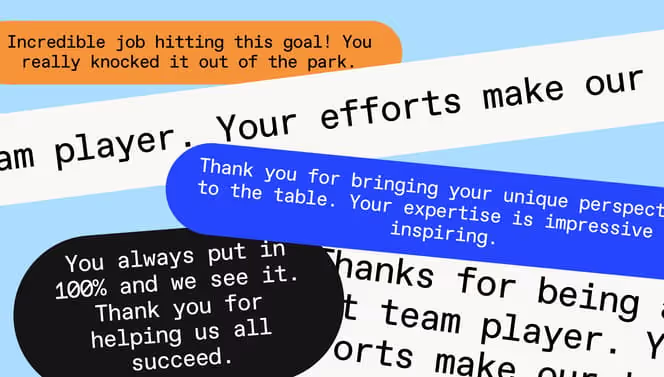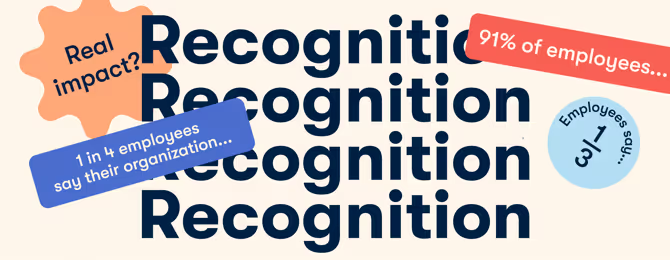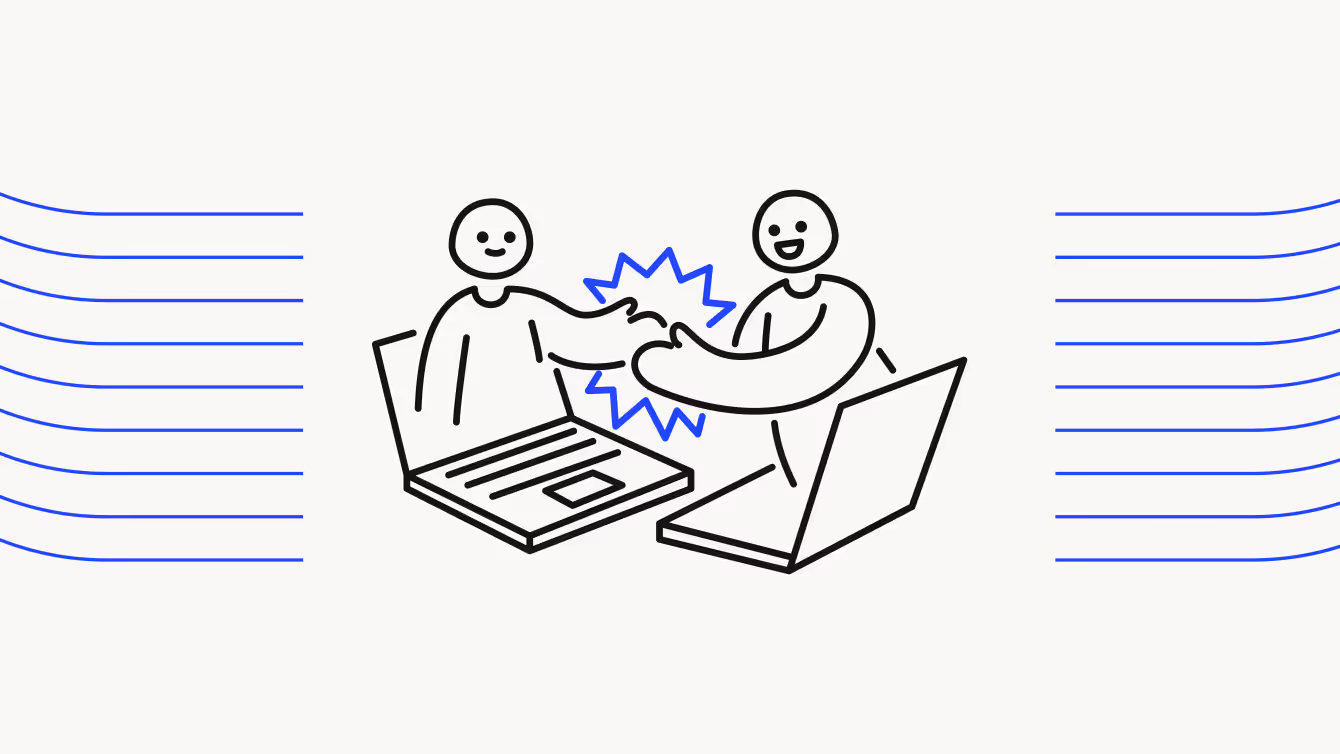30+ employee recognition messages to inspire and motivate your team

%20(1).png)
If you want your employee engagement and performance to grow, your team needs to feel seen, appreciated, and recognized for their efforts. And, as a manager, that means letting them know you see, appreciate, and recognize them.
In other words, it's vital to make employee recognition a priority. We know you're busy, so we put together some words of appreciation and examples for common situations that call for effective recognition.
It’s important to recognize your employees on a regular basis. But finding the time to craft meaningful messages about their employee work can be challenging.
Use the employee recognition examples in this article as inspiration for expressing gratitude and enhancing the overall employee experience.
Key takeaways:
- Recognition is at the heart of employee engagement, emphasizing the value of employees' contributions and performance metrics. When managers, peers, and leaders show appreciation for good performance, efforts, and participation, employees are more motivated to excel, highlighting the benefits of employee recognition.
- Managers can use the employee recognition examples provided in this article to streamline their approach and create meaningful messages of appreciation.
- There are additional ways to create a culture of recognition at work — from company-wide acknowledgments, employee rewards, moments of celebration, and professional development opportunities.
Employee recognition message examples
As a manager, we get that you might not have extra time in your day to plan elaborate employee recognition ideas. However, quick words of appreciation and positive feedback can have a huge and lasting impact on morale. Employee appreciation messages listed here are meant to serve as inspiration for formal recognition. We recommend adding your own personal touch rather than copying and pasting generic recognition messages.
Messages for top performance
Recognizing good work makes employees feel seen and valued, reinforcing a positive organizational culture and helping keep them motivated. If they put in the notable effort, or go the extra mile to get results, recognizing high performance is always warranted. Whether you’re continually impressed or an employee has started to really stand out, giving them the shoutout they deserve is never a bad shout.
💡 Here are a few employee recognition examples you could share with someone on your team whose performance calls for some shine:
- “Your outstanding performance is an inspiration to us all. Keep up the amazing work!”
- “Thank you for always putting your best foot forward! Your performance is always top-notch, even when you take on more work.”
- “You’ve really raised the bar this quarter. A performance like yours is a huge asset to the whole team.”
Messages for reaching goals
Employee goal-setting is an important part of helping your entire team reach their full potential, contributing to a positive workplace culture. But setting goals is only one part of the process. If you want to keep your employees motivated, you need to recognize (and celebrate!) when they achieve those goals.
💡 Here are a few employee recognition examples you might use after they hit one of their goals:
- “There was never a doubt in my mind you'd accomplish this, but now that you have, I just want to say congratulations on hitting your goal!”
- “Incredible job hitting this goal! You really knocked it out of the park.”
- “You consistently impress me with your ability to not only set ambitious goals but to achieve them.”
Messages for teamwork
For an entire team to function, every member has to do their part to contribute to the company’s success, embodying our core values. But for some team members, simply showing up and doing their job isn't enough. They go above and beyond what their role calls for while supporting their coworkers and elevating the team.
And those team members deserve some serious recognition.
💡 Here are examples of messages that recognize team members who exceed expectations and contribute to the team above and beyond their roles:
- “Thanks for your contribution today. You went above and beyond and the team really appreciates you!”
- “Thanks for being a great team player. Your efforts make our team stronger!”
- “I just want you to know that your commitment to this team and your willingness to step up and do what needs to be done – even if it falls outside of your job title – don't go unnoticed.”
Messages for outstanding dedication
Exemplary work ethic always deserves to be recognized, as these employees can serve as an inspiration to the whole team and strengthen our organizational culture. Dedicated employees are the backbone of the organization and should be valued by everyone. The success your team achieves together is thanks to their consistency and commitment. Help keep up the momentum by sending a message of appreciation or encouraging peer nominations for outstanding contributions.
💡 Here are a few employee appreciation quotes to recognize a great employee for their consistent dedication:
- “No matter the situation, you always rise to the occasion! Thank you for your unwavering dedication; it doesn’t go unnoticed.”
- “Thank you for being such a reliable member of this team. We appreciate your work ethic so much!”
- You always put in 100% and we see it. Thank you for helping us all succeed.
Messages for growth and improvement
As a manager, your role is to empower your team members to be their best selves at work, fostering a culture that values continuous improvement. If your employees soak up feedback and constantly work towards improving their skill sets, kudos should definitely be served.
💡 Here are a few employee appreciation messages to show your team you notice and celebrate their improvements:
- “You accept feedback like no other and it’s a pleasure to see you flourish in your role!”
- “Your drive for constant improvement is contagious. Thank you for inspiring the team to be the best they can be.”
- “Over the last few months, we’ve noticed a huge improvement in X skillset. Your effort does not go unnoticed and we’re proud to see you grow.”
Messages for unique expertise
A great team is one that’s made up of diverse skill sets and perspectives, reflecting a strong organizational culture. Leveraging your employees’ strengths not only gives them the chance to show what they’re capable of but is also beneficial to the whole team by helping them achieve goals together. Drop an appreciation note the next time someone on your team steps up to bring their unique skills to the table.
💡 Here are some of the best employee appreciation quotes to recognize someone’s standout skills:
- “Your expertise on X really gave us valuable insights. Thanks for sharing your knowledge with us all!”
- “We’re so impressed with your expertise on X. You’re awesome at what you do and you bring great value to the team.”
- “Thank you for bringing your unique perspective to the table. Your expertise is impressive and inspiring.”
Messages of appreciation for a noteworthy attitude
An employee who shows up to work with a great attitude can completely change the vibe of the team, enhancing the overall workplace culture. They're easier to work with, they're fun to be around, and they make for a more positive, supportive work environment. Good energy goes a long way in the workplace, so why not pay the employee happiness forward?
💡 Here are a few employee appreciation messages you can pass along to help keep the good energy flowing:
- “Working hard is important. But working kindly is just as important, and you've nailed both! Thanks for being such a pleasure to work with.”
- “Your upbeat attitude is contagious, and it makes our team (and our organization!) better. Thanks for bringing positivity to work every day!”
- “Your optimism, happiness, and overall positive attitude is an asset to this team. Thank you for being you!”
Messages of recognition for efforts during hard times
All the examples we've covered so far have been about recognizing employees when things are going well. And while it's important to recognize your team when things are on the up and up, it's just as important to recognize them when things aren't going so well.
Motivation has a tendency to dip when times are hard. For example, during a challenging project, when a key team member leaves, or during times of transition or change.
If you want to keep your team moving forward during challenging times, a little employee appreciation and recognition go a long way.
💡 Here are a few employee appreciation messages you can use to recognize your team's efforts when work is more challenging, hard, or uncertain:
- “I know things haven't been easy. But I just wanted to thank you for always showing up and supporting this team, even when it's hard.”
- “Things have been tough, but every day you show up, roll up your sleeves, and make things happen. Thanks for pushing through, we appreciate you!”
- “It's easy to show up with a smile on your face when things are going well. But you've continued to show up with a smile on your face, even when things have been tough. Thanks for all you do!”
Additional examples to recognize employees
Recognition is a key tool to motivate and inspire employees. By being generous with employee appreciation messages, managers can ensure everyone in the team feels acknowledged, recognized, celebrated, and inspired to do their best work.
But are employee appreciation messages a responsibility that falls solely on managers? Appreciation can come from everywhere — from peers to leaders. And it should!
Peer-to-peer recognition examples
Colleagues have the unique ability to provide kudos to one another, especially when it comes to highlighting day-to-day collaboration wins, fostering a culture of social recognition.
It’s important to encourage peer-to-peer recognition because team members notice the small efforts, like helping out with a task or providing advice, that might not always make their back to managers.
That said, not everyone has a way around words, so managers can provide a few examples to help break the ice.
💡 Here are a few peer-to-peer recognition examples for employees to use as inspiration to show appreciation for their colleagues:
- “Thanks so much for your help earlier on X. I was stuck and your advice was very useful. You really know what you’re doing!”
- “I appreciate every time you offer to get us coffee before a meeting. We get so caught up in the stress of the day that these little moments of consideration mean a lot!”
- “I admired the way you delivered that presentation to the client earlier. You spoke confidently and helped deliver the message clearly. I was impressed!”
Leadership message to employees examples
Leadership recognition is powerful. A top-down approach ensures appreciation starts at the highest levels and shapes company culture. It reassures employees that their efforts are seen by decision-makers — especially motivating for those seeking promotion.
These messages also show leaders' active involvement. Since they don’t interact with everyone daily, recognition signals attention and care that might otherwise go unnoticed.
💡 Here are some key messages leaders can use to show their recognition to their workforce:
- “I want to express my sincere appreciation for your hard work. Your efforts haven’t gone unnoticed and were acknowledged at our last leadership meeting!”
- “X told me it was your idea to suggest an improvement of our processes. I am impressed by your problem-solving mindset and encourage you to keep sharing your great ideas!”
- “I’ve noticed consistent feedback from your peers that your team-oriented attitude has made a positive impact on everyone. Thank you for being a part of what makes this company great to work at!”
Recognition examples that go beyond words
No two people are made the same, and every employee has a different ideal when it comes to appreciation, highlighting the need for diverse types of employee recognition.
Public recognition might be great for the extroverts on your team, for example, while some may lean more towards actions beyond words. Here are a few positive recognition examples that come to life outside of the standard written message format:
Moments of celebration at work
Team celebrations or work anniversary celebrations are opportunities to acknowledge milestones, achievements, and special occasions together, strengthening our workplace culture. Whether it’s a team lunch, cake to celebrate a colleague’s workiversary, or after-work team drinks to acknowledge a special project completed — moments of celebration shared together instil pride within employees and strengthen bonds between team members.
Professional development opportunities
When a company invests in its employees’ professional development, it’s a powerful demonstration of recognition. It communicates: We see how hard you work, we believe in your success, and we’re here to help you strive. Offering development opportunities like training, skill development, or career advancement lets employees know they are worth being bet on, which can improve employee retention.
Professional opportunities come in all shapes and forms. They can be access to online learning, mentorship programs, or even sponsored attendances to industry conferences your employees would love to be a part of.
Flexible work options
Now, this one might not be an obvious team member recognition tactic — so allow us to explain! While flexible work options are more commonplace these days, they aren’t necessarily a given, but they can serve as effective incentives for employees. But if managers want to boost appreciation and recognition, they might want to consider this creative work scheme. How so?
When employees are offered the option to adjust their work schedule, it shows that they are trusted to complete their tasks even outside of normal hours. It tells them that their level of responsibility, commitment, and autonomy is recognized. This can be a great reward system that gives an allowance for employees to use for personal events or projects that require them to adjust their work hours.
Looking to transform your company culture? Click here for some essential employee recognition tips that are sure to help motivate your modern workforce and enhance employee retention.
Bottom line: Recognition matters, so make it a habit at your organization
Your company values its employees and the great work they do, so make sure they know it. An employee recognition program can be beneficial to any work culture, and research by Bersin shows that it can even reduce turnover by 31%.
Whether through words, rewards, or career development opportunities, recognition initiatives help create a thriving workplace culture.
By fostering an environment where appreciation is a regular practice, you empower employees to feel valued and motivated. Start small, be consistent, and watch your team’s engagement grow!
Recognize employees properly
Learn everything you need to know about employee recognition and how to implement it in your team by downloading the complete guide below.
%20(1).png)

%20(1).avif)


.avif)
.avif)



.png)




